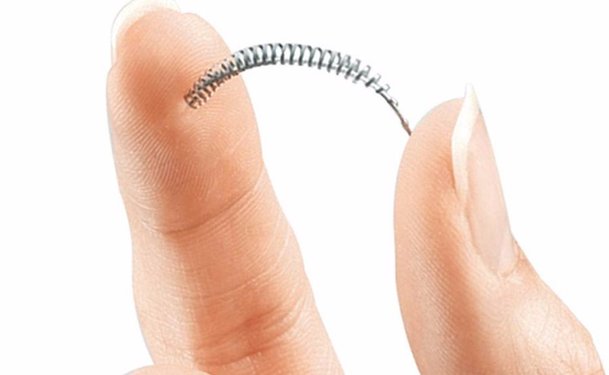When choosing a method of permanent birth control, itís important to look for proven long-term effectiveness. Since the 1960s, vasectomy, a safe, simple, and highly effective procedure,has been one of the most popular forms of contraception in the United States and worldwide. Couples who want highly reliable birth control options and permanent forms of contraception often choose vasectomy, for which the success rate is more than 99%.1 Although some newer "permanent" contraceptive procedures are now available, you may be surprised to learn that the success rates of these types of birth control may be lower than that of vasectomy. One new permanent contraceptive procedure, Essure, has only been proven effective for up to five years,2 and very little is known about how well it will work beyond those first five years.3
The Essure procedure
In the Essure procedure, a micro-insert (a tiny metal coil) is delivered through the vagina and uterus and placed into each of the woman's two fallopian tubes.2 Once in place, scar tissue gradually forms in and around these micro-inserts, creating a barrier that blocks the fallopian tubes so that sperm cannot reach the woman's eggs. The procedure is done via hysteroscopy on an outpatient basis (cost ranging from $1300 to $3500)4 and is usually an in-office procedure. In comparison, vasectomy, which is also usually performed in the physician's office, typically costs in therange of $500 to $1000.1
However, in Essure clinical studies,5-8 not every woman achieved success with the micro-inserts. In fact, the Center for Women's Health reports that as many as one in seven women did not achieve successful placement of both micro-inserts during the first placement procedure,although some of these women chose to undergo a second hysteroscope procedure, wherein both micro-inserts were placed successfully, and subsequently were able to rely on Essure for contraception.3 By contrast, birth control for men by way of vasectomy is over 99% effective.
Differences in quality assurance with Essure and vasectomies
Neither the micro-inserts nor a vasectomy provides immediate contraception. However, while confirmation of sterilization with vasectomy involves only a simple semen sample, confirmation after an Essure procedure requires at least one hysterosalpingogram (an x-ray procedure using contrast dye) of the uterus.2 When it is successful, the Essure procedure is said to be similar to that of vasectomy; however, there is less long-term information about results with the micro-inserts than there is for vasectomy. Immediately following the procedures, vasectomy recovery and expected recovery period for Essure takes only a few days.
A small group of physicians was asked to answer a series of questions about their opinions about Essure. One third of the physicians who participated in this survey on the micro-inserts preferred vasectomy as a method of permanent contraception.9
While a vasectomy is considered permanent, vasectomy reversals are performed at the rate of more than 50,000 per year. Based upon a number of factors, the statistical probability of reopening the vas channel can be as high as 97% (but also as low as 71%).10
Conclusion
While no known published data exist on the safety or effectiveness to support the reversibility of an Essure procedure, any attempt to surgically reverse the Essure procedure would require more major surgery (an abdominal incision and, most likely, general anesthesia) with uncertain success and risk.
References
- The vasectomy procedure: vasectomy is a safe, simple and effective birth control method. Vasectomy.com Web site. http://www.vasectomy.com/ProcedureDetail.asp?siteid=V&id=10. Accessed April 7, 2009.
- Overview of Essure. Essure Web site. http://www.essure.com/Home/Understanding/WhatisEssure/tabid/55/Default.aspx. Accessed April 7, 2009.
- Conceptus Inc. EssureÆ: summary of risks and other important information. Essure Web site. http://www.essure.com/Portals/0/Skins/Conceptus_Skin/PDFs/CC-1077-01_30Jan06F_ConsSafetySummary_English.pdf. Accessed April 7, 2009.
- Birth control guide: Essure. MayoClinic.com Web site. http://www.mayoclinic.com/health/birth-control/BI99999/PAGE=BI00034. Accessed April 7, 2009.
- Kerin JF, Carignan CS, Cher D. The safety and effectiveness of a new hysteroscopic method for permanent birth control: results of the first Essure pbc clinical study. Aust N Z J Obstet Gynaecol. 2001;41(4):364-370.
- Kerin JF, Cooper JM, Price T, et al. Hysteroscopic sterilization using a micro-insert device: results of a multicentre phase II study. Hum Reprod. 2003;18(6):1223-1230.
- Cooper JM, Carignan CS, Cher D, et al. Microinsert nonincisional hysteroscopic sterilization. Obstet Gynecol. 2003;102(1):59-67.
- Duffy S, Marsh F, Rogerson L, et al. Female sterilisation: a cohort controlled comparative study of ESSURE versus laparoscopic sterilisation. BJOG. 2005;112(11):1522-1528.
- Essure permanent birth control: market assessment; February 2007. Panel Intelligence Web site. http://www.medpanel.com/reports/essure_permanent_birth_control. Accessed April 7, 2009.
- The vasectomy reversal procedure: vasectomy reversal is a safe, delicate microsurgical procedure that is growing in availability and popularity. Vasectomy.com Web site. http://www.vasectomy.com/procedureDetail.asp?siteid=R&Id=11. Accessed Paril 7, 2009.


